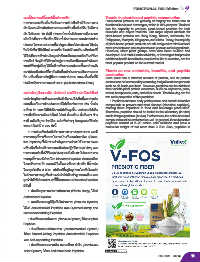Page 79 - FoodFocusThailand No.203 February 2023
P. 79
FUNCTIONAL F&B Edition
แนวโน้มการบริโภคเปปไทด์์จากพืืช Trends in plant-based peptide consumption
อาหารและเคร่�องดื่่�มที่่�ผลิตมาจากโปรต่นพื่ชม่ที่ิศที่างการ Plant-based proteins are growing at roughly the same rate as
functional foods and beverages, which is 10% per year. Thailand
เติบโตเช่นเดื่่ยวกันกับอาหารและเคร่�องดื่่�มฟัังก์ชัน ซึ่่�งม่การ has the capacity to produce plant-based proteins for both
เติบโตร้อยละ 10 ต่อปี ประเที่ศไที่ยนั�นม่ศักยภาพืที่่�สามารถ domestic and export markets. Our major export markets for
ผลิตโปรต่นจากพื่ชเพื่�อบริโภคที่ั�งในประเที่ศและส่งออกต่าง plant-based proteins are Hong Kong, Taiwan, Indonesia, the
Philippines, Malaysia, Singapore, and China. Today, the majority
ประเที่ศ โดื่ยตลาดื่ส่งออกที่่�สำาคัญของไที่ย ไดื่้แก่ ฮ่่องกง ไต้หวัน of plant-based protein products are still designed to mimic animal
อินโดื่น่เซึ่่ย ฟัิลิปปินส์ มาเลเซึ่่ย สิงคโปร์ และจ่น ผลิตภัณฑ์์ที่่� meat products and use soybeans and peas as main ingredients.
However, other plant groups have also been studied and
ใช้โปรต่นจากพื่ชส่วนใหญ่แล้วยังคงเล่ยนแบบผลิตภัณฑ์์ที่่�มา developed. And multi-functional drinks, or beverages that provide
จากสัตว์ วัตถุดื่ิบที่่�ใช้ส่วนใหญ่มาจากถั�วเหล่องและถั�วลันเตา additional health benefits for people who like to exercise, are the
most popular product on the current market.
ขณะที่่�พื่ชกลุ่มอ่�นๆ ไดื่้เริ�มม่การศ่กษาและพืัฒนาข่�นมาบ้างแล้ว
แนวโน้มผลิตภัณฑ์์ที่่�กำาลังเป็นที่่�สนใจในตลาดื่เป็นอย่างมาก Plants as raw materials, benefits, and peptide
ค่อ เคร่�องดื่่�มสำาหรับผ้้ที่่�ชอบออกกำาลังกาย และเคร่�องดื่่�มที่่�ม่ production
Each plant has a different amount of protein, and its protein
ประโยชน์หลากหลายต่อร่างกาย (Multi-functional Drink) content can be increased by extracting insignificant components
such as oil, husk, and bran. However, peptides can be obtained
from various plant protein resources, such as soybeans, peas,
แหล่่งวัตถุุด์ิบจากพืืช ประโยชน์ แล่ะวิธีีการผล่ิตเปปไทด์์ wheat, hempseeds, oats, and other seeds. The following are the
แหล่งวัตถุดื่ิบจากพื่ชแต่ละชนิดื่ม่ปริมาณโปรต่นที่่�แตกต่างกัน two main properties of the peptides:
• Peptides enhance body performance and contain bioactive
และเม่�อสกัดื่เอาส่วนประกอบที่่�ไม่เก่�ยวข้องออก เช่น นำ�ามัน compounds to prevent and treat disease (bioactive peptides),
เปล่อก รำา จะที่ำาให้ไดื่้ปริมาณโปรต่นส้งข่�น แหล่งของโปรต่น making them important in food and beverage production.
จากพื่ชที่่�นำามาผลิตเปปไที่ดื่์ ไดื่้แก่ ถั�วเหล่อง ถั�วลันเตา ข้าว Therefore, peptides should be tested in the laboratory (in vitro)
and in living organisms (in vivo). Furthermore, the active chemical
สาล่ เมล็ดื่กัญชง ข้าวโอ๊ต เมล็ดื่พื่ชต่างๆ โดื่ยคุณสมบัติหลัก compound must be evaluated as well. In general, these bioactive
ของเปปไที่ดื่์ ม่ 2 ส่วน ดื่ังน่� peptides consist of 2–20 amino acid residues and have a
molecular weight of not more than 3 kDa. Also, peptides in
1. การส่งเสริมประสิที่ธิิภาพืการที่ำางานของร่างกาย และม่
สารออกฤที่ธิิ�ที่างช่วภาพืในการป้องกันและรักษาโรค (Bioac-
tive Peptides) ซึ่่�งม่ความสำาคัญต่อการนำามาใช้ในอาหารและ
เคร่�องดื่่�ม จ่งต้องม่การที่ดื่สอบในห้องปฏิิบัติการ (In Vitro) และ
การที่ดื่ลองกับสิ�งม่ช่วิต (In Vivo) รวมถ่งต้องนำาไปที่ดื่สอบสาร
ออกฤที่ธิิ�ที่างเคม่ดื่้วย โดื่ย Bioactive Peptides ประกอบดื่้วย
โครงสร้างย่อย ค่อ กรดื่อะมิโนตั�งแต่ 2 ถ่ง 20 ตัว หร่อ ม่นำ�าหนัก
โมเลกุลไม่เกิน 3 kDa เปปไที่ดื่์ที่่�อย้่ในร้ปของไดื่หร่อไตรเปป
ไที่ดื่์ จะสามารถดื่้ดื่ซึ่่มผ่านผนังลำาไส้เล็กเข้าส้่กระแสเล่อดื่ และ
ถ้กนำาไปใช้ไดื่้ง่ายกว่า ฤที่ธิิ�ที่่�โดื่ดื่เดื่่นของ Bioactive Peptides
ม่ดื่ังน่�
• ส่งเสริมสุขภาพืร่างกายโดื่ยรวม (Whole Body) ไดื่้แก่
Antioxidant Peptides
• ส่งเสริมระบบภ้มิคุ้มกันในร่างกาย (Immune System)
ไดื่้แก่ Anti-microbial Peptides และ Cytomodulatory and
Immunomodulating Peptides
• ส่งเสริมระบบประสาที่ (Nervous System) ไดื่้แก่ Opioid
Peptides
• ส่งเสริมระบบย่อยอาหาร (Gastrointestinal System)
ไดื่้แก่ Mineral-biding Peptides Anti-microbial Peptides
และ Anti-appetizing Peptides
• ส่งเสริมระบบความดื่ัน หลอดื่เล่อดื่ หัวใจ (Cardiovas-
cular System) ไดื่้แก่ Anti-thrombotic Peptides
FEB 2023 NO. 64 79
20/1/2566 BE 13:11
78-81_Func_��������� 4_������.indd 79
78-81_Func_��������� 4_������.indd 79 20/1/2566 BE 13:11

